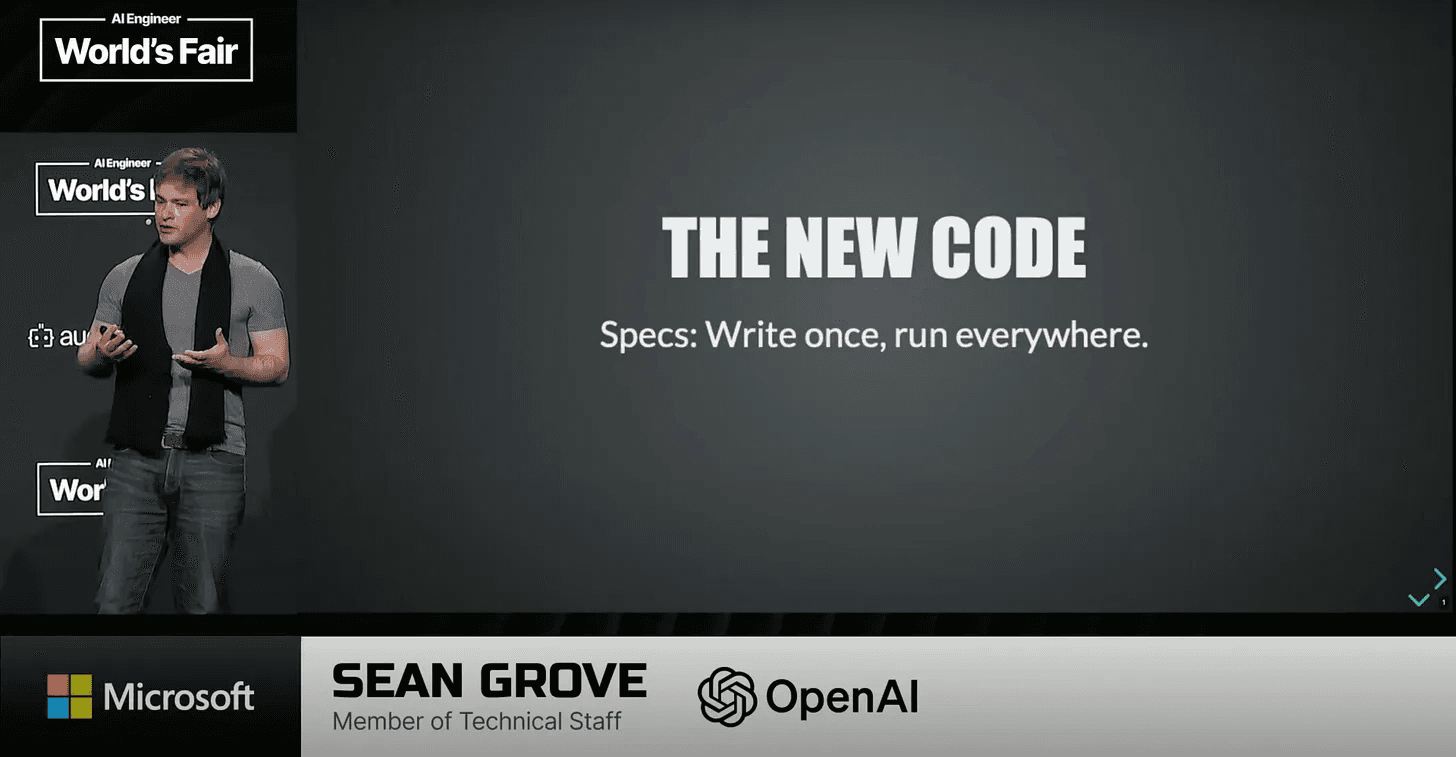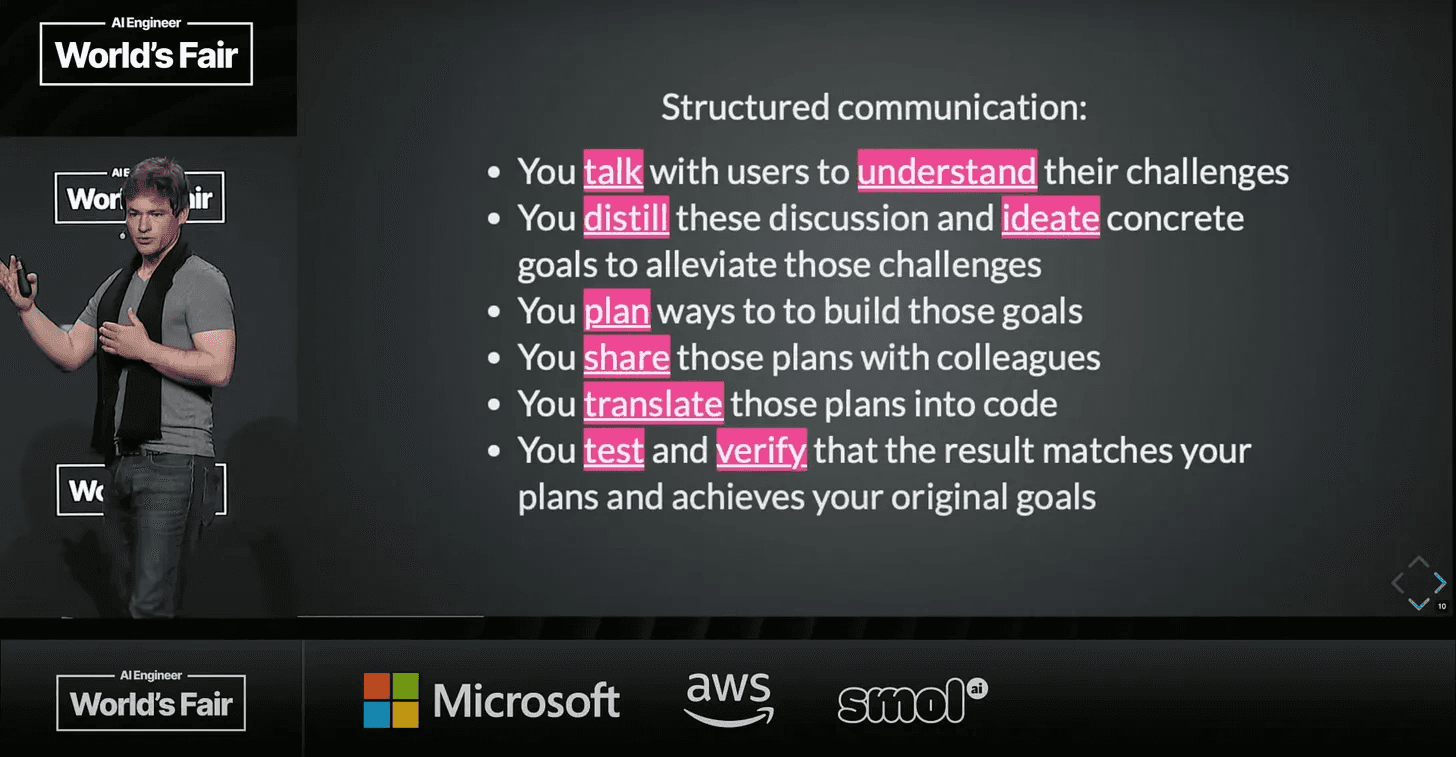•
1 min read
Prompt engineering is dead. Do this instead."
Specifications are the new code, and they’re transforming AI development into a collaborative, transparent, and human-centered process. Share this newsletter with your team, start writing your first specification, and join the movement to build AI that truly understands and delivers on human intent.

Last week, we explored context engineering the art of giving AI the right tools, memory, and context to think effectively.
Today, we’re going one level deeper.
If context engineering is about “how” an AI thinks, spec engineering is about “what” it should think about and why.
This shift isn’t just technical. It’s a complete reframe of what it means to build software in the AI era.
We dive into a transformative approach to building AI systems, inspired by Sean Grove’s talk, “The New Code.” Say goodbye to fleeting prompts and hello to structured, reusable specifications that align teams, models, and outcomes. Here’s why specifications are the key to unlocking the full potential of AI development.

Why Specifications trump Prompt Engineering
Sean Grove (OpenAI) recently introduced a powerful idea:
“Code is just 10–20% of the value you create. The other 80–90% comes from structured communication.”
Think about your last project:
How much time did you spend writing code vs. gathering requirements?
How much energy was spent aligning stakeholders vs. debugging syntax?
The bottleneck is intent clarity.
Even with the best AI tools, if you can’t express what you want, why you want it, and how you’ll measure success, you’ll end up vibe coding your way into chaos.
Spec engineering solves this.
It’s about designing a living specification a single, executable source of truth that aligns humans and AI before the first line of code is generated.
Prompt engineering, while intuitive, is like vibe coding ephemeral and inefficient. As Grove highlights, prompts are often discarded after generating code, leaving the true intent behind the code untracked. This is akin to shredding source code and cherishing the binary. Instead, specifications offer a structured, human-readable, and version-controlled way to capture intent, making them the cornerstone of modern AI development.
Align Humans and Models: Specifications serve as a “trust anchor,” aligning teams around shared goals and values, as seen in OpenAI’s Model Spec. They ensure everyone from engineers to product managers speaks the same language.
Executable and Reusable: Unlike prompts, specifications can be fed directly to AI models, producing consistent outputs like code, documentation, or even podcasts. They’re the source code for AI, portable across platforms and use cases.
Reduce Ambiguity: Specifications, like the US Constitution for lawmakers, provide clear, testable criteria for success, minimizing miscommunication and errors.

Structured Communication: The Six Steps
Grove breaks down what real engineering looks like as a process of structured communication, not just coding. Here’s how each step maps to spec engineering:
1. Talk to Understand
The first step is having conversations with users to understand their real challenges.
For AI systems, this means defining problems worth solving—not just building features but clarifying the “why” behind them.
2. Distill and Ideate
From these conversations, you distill insights and ideate clear, actionable goals.
In spec engineering, this becomes a structured artifact: a set of well-defined success criteria that AI can work against.
3. Plan
You then plan the path to achieving those goals.
This is the blueprint phase specs define the strategy and steps, just like a product roadmap.
4. Share
You share the plan with your team, ensuring alignment across product, engineering, and design.
With specifications, you get a single source of truth that everyone can read, discuss, and agree upon removing ambiguity.
5. Translate
This is where translation into code happens.
AI models excel here when they have a rich, structured spec to reference—generating consistent outputs, whether it’s code, tests, or documentation.
6. Test and Verify
Finally, you test and verify outcomes against the original goals.
A great spec isn’t just a plan it’s also a benchmark for success, ensuring the delivered output truly solves the problem.
To be clear, this isn’t a total rejection of the vibe, it’s an evolution. You still get the rapid iteration and creative flow of working with AI (in fact, iteration cycles might be even faster when the AI can regenerate entire modules to match a revised spec). But now there’s a safety net. The spec is the agreed-upon contract of what we’re making. If the AI’s output doesn’t meet it, we know exactly where and why, and we update the spec or correct the AI. Contrast that with vibe coding’s trial-and-error: you might not even know something was off until users or testers stumble on it.
A good analogy is the difference between improvising music and composing a score. Vibe coding is jazz, fun and inventive, but can get messy. Spec engineering is writing the sheet music then letting talented musicians (AI agents) perform it. When everyone’s following the same score, the result is more predictable and harmonized.
Codiris is made of AI agents collaborating under human guidance. We’re not just swapping out human coders for ai coders; we’re orchestrating whole fleets of AI specialists. This is where spec engineering truly shines: a good spec can be parcelled out to multiple AI agents, each expert in its domain, working in parallel. The spec becomes the lingua franca for your design agent, coding agent, testing agent, etc., ensuring they all know the end goal and their part in achieving it. The human’s role shifts from writing code to conducting the AI “orchestra” a role that blends software architect and product manager.
As one observer noted, future architects will take product requirements (PRDs) and act as “managers of the AI agents,” coordinating their work and making decisions at a high level. This is exactly what spec engineers do.
Spec Engineering in action: How Codiris builds like a dream team
All of this talk about spec engineering sounds great in theory but what does it actually look like in practice?
Enter Codiris, an AI-native Product Development Environment (PDE) that’s redefining what it means to build software. Think of it as an AI-powered product team in a box a suite of specialized AI agents that handle everything from product research to design, coding, testing, and deployment.
But here’s the twist: you don’t feed Codiris code you feed it specifications.
From Idea to Specification
Every great product begins with a simple question: What problem are we solving?
With Codiris, you don’t start with code you start with a conversation.
You describe your idea in plain language, no technical jargon needed. Then Codiris brainstorms with you, asking sharp, product-focused questions:
Who is this for?
What real pain are we solving?
What would success look like?
And here’s the kicker: Codiris also tackles the part everyone avoids but that truly defines success, market and user research. It scours the landscape, surfaces insights, and validates assumptions, helping you avoid the classic trap of building something nobody actually wants.
Armed with this knowledge, Codiris transforms your raw ideas into structured, actionable feature requirements and maps out the desired outcomes all before a single line of code is written.
From vision to blueprint
Once your idea is clear, Codiris takes over the heavy lifting of spec writing.
The AI automatically generates detailed, prioritized user stories, each one tied directly to the user problems you’ve defined.
In a traditional team, this is where a product manager drafts specs, and a tech lead translates them into developer tickets. With Codiris, that entire flow happens instantly and it’s always guided by your high-level vision.
Design & Architecture Driven by Specs
Once the specs are clear, Codiris’ design agents step in. They create wireframes, UI flows, and system architecture directly from the specification.
The spec becomes the single source of truth:
Designs are validated against the spec.
Architecture is derived from the requirements.
By the time coding begins, Codiris’ AI agents have a crystal-clear blueprint to execute.
Coding Without Chaos
This is where Codiris truly shines.
Instead of one big, monolithic AI model trying to “guess” what you want, Codiris uses a multi-agent engineering team:
A Lead Engineer Agent orchestrates the work.
Frontend and Backend Agents generate clean, production-grade code.
A QA Agent writes and runs automated tests.
Every line of code they produce is anchored to the specification. If a test fails, the coding agent revisits the spec, fixes the logic, and re-tests just like a real dev team, but with 24/7 speed and precision.
Alignment = The Secret Sauce
The magic of Codiris isn’t just in automation it’s in alignment.
Because everything flows from a shared spec, every AI agent knows exactly:
What functionality to build (from the user story),
What success looks like (from acceptance criteria),
And what constraints matter (performance, compliance, etc.).
This keeps the entire development pipeline coherent and adaptive.
If you tweak a requirement mid-way, the entire AI team adjusts automatically no messy hand-offs or communication gaps.
You stay the visionary, Not the typist
As the human in the loop, you’re still the captain of the ship.
Your job isn’t writing boilerplate code or test cases it’s steering the vision through the spec.
You chat with AI agents like you would with team leads:
“Does this feature flow make sense?”
“What if we change this requirement?”
The system learns as it goes, remembering context (thanks to context engineering) so every adjustment ripples through the entire project seamlessly.
The results are game-changing
Early adopters of Codiris report staggering improvements:
MVPs built 80% faster (days instead of months).
60% reduction in wasted effort by catching missteps before coding even starts.
Code that’s traceable and maintainable because every component maps back to a specific spec.
One user described the experience as:
“It feels like having a world-class product team working alongside us 24/7. We set the vision, and Codiris just executes.”
The Human-AI partnership
Spec engineering with Codiris doesn’t replace human creativity, it amplifies it.
You decide what the product should do, while Codiris figures out how to make it happen. Mundane tasks like repetitive coding or testing vanish, freeing you to focus on strategy, vision, and user value.
This is the future of AI-native product building, where specs are the shared language that humans and AI collaborate on, and execution becomes as seamless as updating a document.
The Future of AI Development
Grove envisions a future where the Integrated Development Environment (IDE) evolves into an “Integrated Thought Clarifier.” This tool would help authors refine specifications by flagging ambiguous language, suggesting clearer phrasing, and ensuring alignment across teams and models. Imagine a tool that not only writes code but also clarifies your intent, making communication as precise as programming.
This shift also raises exciting questions: What does it mean to be a programmer in a world where specifications are king? As Grove notes, “Software engineering has never been about code.” It’s about solving human problems through precise exploration. Specifications bring us closer to that goal by unifying human intent with AI execution.
Next time you work on an AI feature, start with a specification. Ask:
What do I want to achieve?
How will I measure success?
Is my intent clear to both humans and models?
Debate the specification with your team, test it against your AI model, and version it for collaboration. By mastering specifications, you’ll not only build better AI systems but also become a more effective communicator and problem-solver.
If you dont know how to do it yourself very well just use codiris.
Specifications are the new code, and they’re transforming AI development into a collaborative, transparent, and human-centered process. Share this newsletter with your team, start writing your first specification, and join the movement to build AI that truly understands and delivers on human intent.
Inspired by Sean Grove’s “The New Code” talk at AI engineer conference.
We’re building something big and want to bring more pioneers on board. Email me at joel@humiris.ai if you’d like early access, a demo, or simply to exchange ideas on the future of AI development driven by spec engineering.